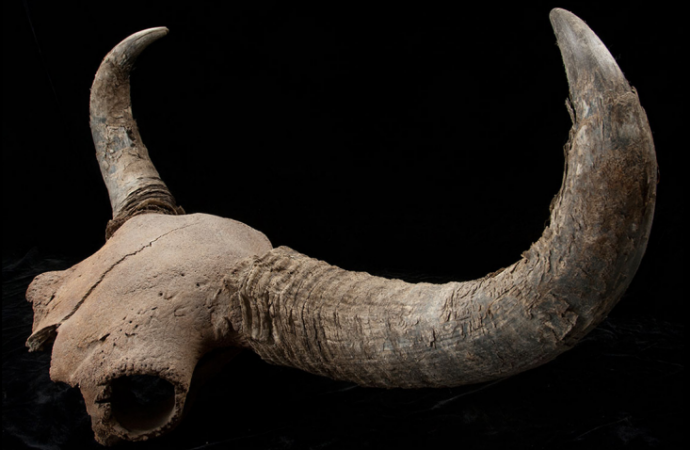For most of the last ice age, enormous glaciers covered western Canada. And yet people still managed to cross deep into the Americas from their settlements in western Alaska. How did they do it?
Archaeologists once thought a narrow strip of land opened up between the glaciers, allowing them passage. But others suspect the migrants hopped down the Pacific coast in boats long before that happened. Now, a new study of bison fossils offers the most precise date yet for the opening of the ice-free corridor: 13,000 years ago. Combined with evidence of earlier occupations in the lower 48, it suggests the corridor could not have been the first route people took into the New World.
“This is the first strong empirical data indicating when that corridor was viable,” says Michael Waters, an archaeologist at Texas A&M University, College Station. “It’s indirect evidence, but it’s still strong evidence.”
The opening date has loomed large in debates about the settling of the Americas. Researchers long thought that Clovis hunters, identified by their distinctive “fluted” spear points marked with long, shallow grooves, followed game south through the corridor more than 13,000 years ago, when their tools begin to show up in the continental United States. Recently discovered evidence of earlier human habitation in the Americas suggested they may have used a different, more ancient route. But hard data on the corridor were virtually nonexistent. Geoscientist Duane Froese and archaeologist Jack Ives, both at the University of Alberta, Edmonton, in Canada, were disappointed when they reviewed the literature a few years ago. “It [hadn’t] really moved much in the last 20 years,” Froese says.
So Froese and Ives set out to find when the corridor became habitable using a new tool: bison fossils. Bison were already in North America when the glaciers began to grow, and the ice separated their populations into northern and southern branches. During that time, southern bison experienced a dramatic die-off, shrinking to just a few closely related individuals. When the population began to grow again, they all had very similar genes. In particular, their mitochondrial DNA—genes in the power plants of cells, passed down only from the mother—was basically identical. By the time the ice sheets receded thousands of years later, “bison in the south all look the same, and bison in the north look different,” says Beth Shapiro, an evolutionary biologist at the University of California, Santa Cruz. So to tell which group a bison fossil belonged to, all she had to do was sequence its mitochondrial DNA. Finding a southern bison in the north or a northern bison in the south would indicate that the animals were successfully traversing the ice-free corridor. Radiocarbon dates from collagen in the fossils could reveal exactly when that had happened.
Northern and southern bison were mingling within the ice-free corridor by about 13,000 years ago, the team reports online today in the Proceedings of the National Academy of Sciences. That’s right around the first appearance of Clovis points. But it’s well after a handful of sites dated to the pre-Clovis period, including Page-Ladson in Florida, where archaeologists recently discovered a 14,500-year-old stone biface.
Still, the corridor may have been important for people on the move. “It may not have been Highway 1” into the New World, Ives says. “But it was Highway 2.” By the time bison were able to pass through the corridor, he says, humans were already living south of the ice sheets, presumably after traveling down the Pacific coast by boat. “When those ice masses parted, human groups that had been separated for maybe a thousand or even few thousand years would have had a chance to get back in touch with each other,” Ives says—just as the bison appear to have done.
Intriguingly, the researchers found more southern bison using the corridor to move north than northern bison coming south, perhaps because the lower reaches of the corridor became passable while the north was still frozen. If that’s case, it’s likely people did the same, flipping the traditional script about the corridor on its head. “We’ve always historically looked at the corridor as the way that people migrated from Alaska down into the interior of the United States,” says Waters, who excavated Page-Ladson and several other pre-Clovis sites. “But now, we’re seeing that it’s the complete opposite. It’s actually a corridor by which people are traveling back up to the north.” That could explain why fluted points in northern Alaska appear to be younger than those discovered in the lower 48, Ives says: It’s likely that Clovis technology developed in the south, and people carried it north.
Some researchers remain skeptical, however, including Clovis expert Gary Haynes, an archaeologist at the University of Nevada, Reno. He cautions against extrapolating the bison data to humans. “It sets a date for the opening of this corridor to big, gregarious, herding animals, but I don’t know if it necessarily sets a date for the very first movement of humans,” he says. People could have been moving through the corridor long before it was capable of hosting the kind of extensive grassland bison depend on, perhaps by following and hunting less ecologically demanding waterfowl, he says. “It’s tantalizing evidence, but it’s not the slam-dunk kind of evidence.”
Researchers agree that the bison data offer only an upper limit on the habitability of the ice-free corridor; it’s possible that people could have used it before the bison. “It would be great to have solid evidence of humans,” whether through bones or trace amounts of ancient DNA left behind in sediment cores, Shapiro says. “Maybe this [study] will reignite some of the interest in the corridor region, and help people who have other types of expertise or are collecting other types of data to really start focusing on this area again.”
Source: Science mag

































Leave a Comment
You must be logged in to post a comment.